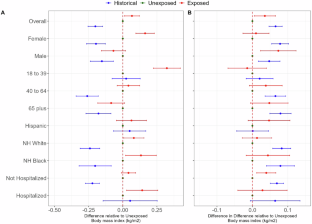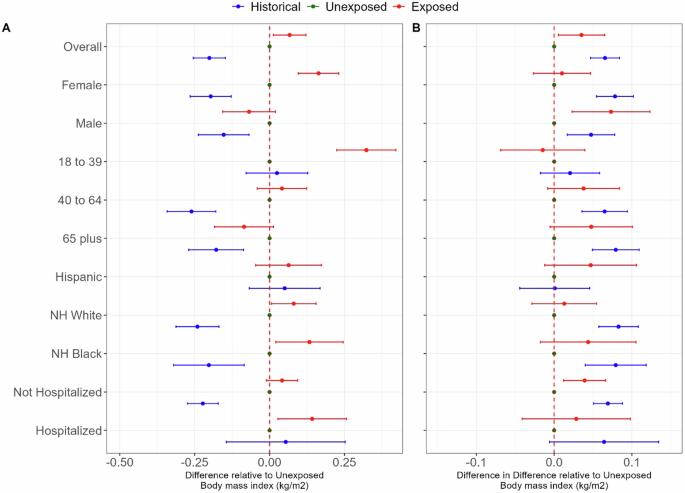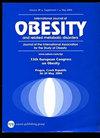体重指数变化及其与 SARS-CoV-2 感染的关系:真实世界分析
IF 4.2
2区 医学
Q1 ENDOCRINOLOGY & METABOLISM
引用次数: 0
摘要
目的 研究 18-99 岁感染和未感染 SARS-CoV-2 的人群的体重指数(BMI)变化。研究对象/方法利用来自美国国家患者中心临床研究网络 OneFlorida+ 临床研究网络的真实数据,我们比较了暴露人群(2020 年 3 月至 2022 年 1 月期间 SARS-CoV-2 检测呈阳性)、当代未暴露人群(SARS-CoV-2 检测呈阴性)和年龄/性别匹配的历史对照人群(2018 年 3 月至 2020 年 1 月)的 BMI 随时间的变化情况。体重指数(BMI)(kg/m2)是从电子健康记录中客观测量的身高和体重中提取的。我们使用目标试验方法估算了未暴露队列和历史对照队列在随访开始时的体重指数,以及相对于暴露队列,按性别、种族& 民族、年龄和住院状态分类的每 100 天随访的体重指数变化。结果研究样本包括 249,743 名参与者(19.2% 为暴露人群,61.5% 为未暴露人群,19.3% 为历史人群),其中 62% 为女性,21.5% 为非西班牙裔黑人,21.4% 为西班牙裔,5.6% 为非西班牙裔其他人群,平均年龄为 51.9 岁(SD:18.9)。在随访开始时,相对于未暴露人群(平均体重指数:29.3 kg/m2 [95% CI: 29.1, 29.4]),暴露人群(0.07 kg/m2 [95% CI; 0.01, 0.12])的平均体重指数较高,而历史对照人群(-0.20 kg/m2 [95% CI; -0.25, -0.15])的平均体重指数较低。在 100 天内,暴露人群的体重指数没有变化(0 kg/m2 [95% CI: -0.03, 0.03]),未暴露人群的体重指数下降(-0.04 kg/m2 [95% CI; -0.05, -0.02]),历史人群的体重指数上升(0.03 kg/m2 [95% CI; 0.01, 0.04])。在大多数亚群中,未暴露队列和暴露队列在随访开始时和 100 天内观察到的体重指数差异是一致的,但在随访开始时,暴露队列中男性和 65 岁或以上人群的体重指数较低。感染 SARS-CoV2 后体重保持的机制和影响仍不清楚。本文章由计算机程序翻译,如有差异,请以英文原文为准。


Body mass index changes and their association with SARS-CoV-2 infection: a real-world analysis
To study body mass index (BMI) changes among individuals aged 18–99 years with and without SARS-CoV-2 infection. Using real-world data from the OneFlorida+ Clinical Research Network of the National Patient-Centered Clinical Research Network, we compared changes over time in BMI in an Exposed cohort (positive SARS-CoV-2 test between March 2020–January 2022), to a contemporary Unexposed cohort (negative SARS-CoV-2 tests), and an age/sex-matched Historical control cohort (March 2018–January 2020). BMI (kg/m2) was retrieved from objective measures of height and weight in electronic health records. We used target trial approaches to estimate BMI at start of follow-up and change per 100 days of follow-up for Unexposed and Historical cohorts relative to the Exposed cohort by categories of sex, race & ethnicity, age, and hospitalization status. The study sample consisted of 249,743 participants (19.2% Exposed, 61.5% Unexposed, 19.3% Historical cohort) of whom 62% were women, 21.5% Non-Hispanic Black, 21.4% Hispanic and 5.6% Non-Hispanic other and had an average age of 51.9 years (SD: 18.9). At start of follow-up, relative to the Unexposed cohort (mean BMI: 29.3 kg/m2 [95% CI: 29.1, 29.4]), the Exposed (0.07 kg/m2 [95% CI; 0.01, 0.12]) had higher mean BMI and Historical controls (−0.20 kg/m2 [95% CI; −0.25, −0.15]) had lower mean BMI. Over 100 days, BMI did not change (0 kg/m2 [95% CI: −0.03, 0.03]) for the Exposed cohort, decreased (−0.04 kg/m2 [95% CI; −0.05, −0.02]) for the Unexposed cohort and increased (0.03 kg/m2 [95% CI; 0.01, 0.04]) for the Historical cohort. Observed differences in BMI at start of follow-up and over 100 days were consistent between Unexposed and Exposed cohorts for most subgroups, except at start of follow-up period among Males and those 65 years or older who had lower BMI among Exposed. In a diverse real-world cohort of adults, mean BMI of those with and without SARS-CoV2 infection varied in their trajectories. The mechanisms and implications of weight retention following SARS-CoV-2 infection remain unclear.
求助全文
通过发布文献求助,成功后即可免费获取论文全文。
去求助
来源期刊

International Journal of Obesity
医学-内分泌学与代谢
CiteScore
10.00
自引率
2.00%
发文量
221
审稿时长
3 months
期刊介绍:
The International Journal of Obesity is a multi-disciplinary forum for research describing basic, clinical and applied studies in biochemistry, physiology, genetics and nutrition, molecular, metabolic, psychological and epidemiological aspects of obesity and related disorders.
We publish a range of content types including original research articles, technical reports, reviews, correspondence and brief communications that elaborate on significant advances in the field and cover topical issues.
 求助内容:
求助内容: 应助结果提醒方式:
应助结果提醒方式:


